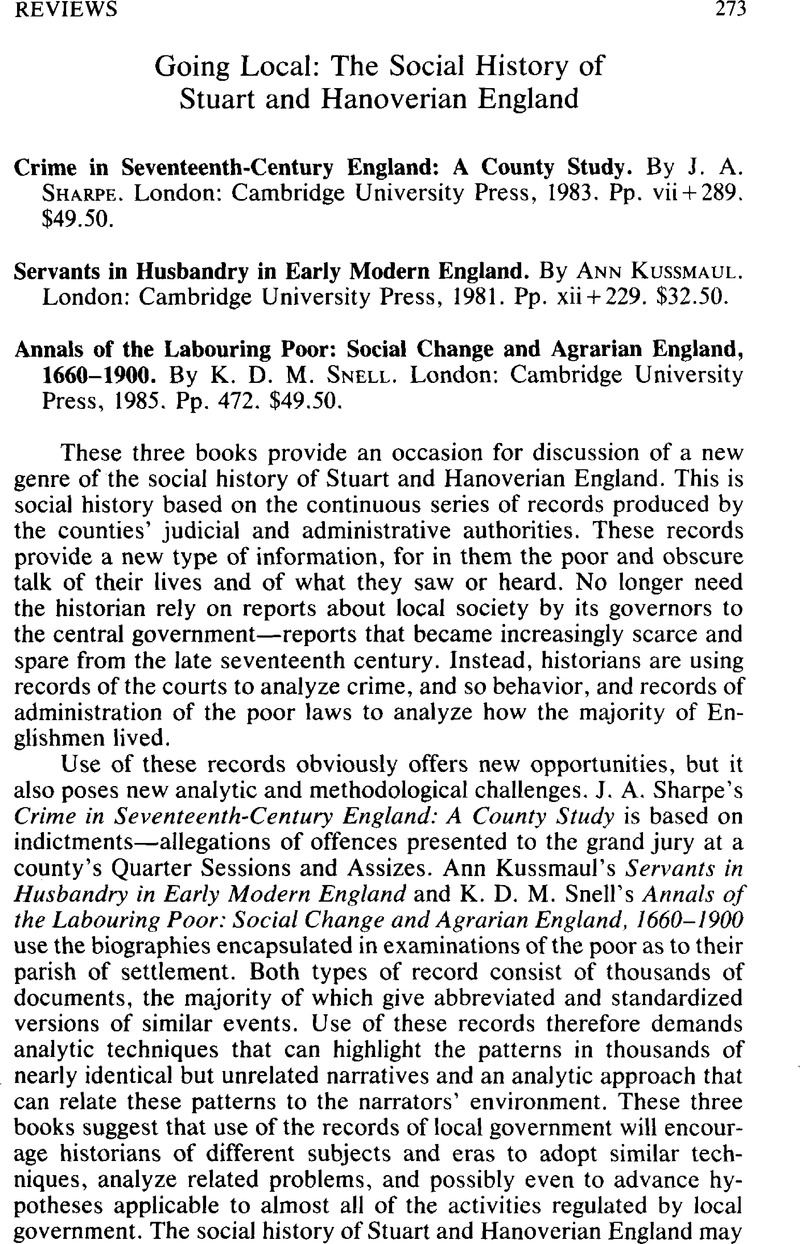No CrossRef data available.
Article contents
Going Local: The Social History of Stuart and Hanoverian England - Crime in Seventeenth-Century England: A County Study. By J. A. Sharpe. London: Cambridge University Press, 1983. Pp. vii + 289. $49.50. - Servants in Husbandry in Early Modern England. By Ann Kussmaul. London: Cambridge University Press, 1981. Pp. xii + 229. $32.50. - Annals of the Labouring Poor: Social Change and Agrarian England, 1660–1900. By K. D. M. Snell. London: Cambridge University Press, 1985. Pp. 472. $49.50.
Published online by Cambridge University Press: 10 January 2014
Abstract

- Type
- Reviews
- Information
- Journal of British Studies , Volume 24 , Issue 2: Politics and Religion in the Early Seventeenth Century: New Voices , April 1985 , pp. 273 - 281
- Copyright
- Copyright © North American Conference of British Studies 1985
References
1 Hay, D., “Property, Authority and the Criminal Law,” in Albion's Fatal Tree, by Hay, D.et al. (New York, 1975)Google Scholar. Many of the contributions to the subject are in collections of essays: the aforementioned Albion's Fatal Tree; Brewer, J. and Styles, J., eds., An Ungovernable People (New Brunswick, N.J., 1980)Google Scholar; Gatrell, V. A. C., Lenman, B., and Parker, G., eds., Crime and the Law: The Social History of Crime in Western Europe since 1500 (London, 1980)Google Scholar; and Cockburn, J. S., ed., Crime in England, 1550–1800 (London, 1977)Google Scholar, which includes a useful bibliography by L. Knafla. More recent works, besides those listed below, include Langbein, J., “The Criminal Trial before the Lawyers,” University of Chicago Law Review 45 (1978): 263–316CrossRefGoogle Scholar; Munsche, P., Gentlemen and Poachers: The English Game Laws, 1671–1831 (Cambridge, 1981)Google Scholar; Wrightson, K. and Levine, D., Poverty and Piety in an English Village: Terling, 1525–1700 (New York, 1979)Google Scholar, chap. 5.
2 The major work on indictments is Beattie, J. M., “The Pattern of Crime in England, 1660–1800,” Past and Present, no. 62 (1974), pp. 47–95Google Scholar.
3 For example, Langbein, J., “Albion's Fatal Flaws,” Past and Present, no. 98 (1983), pp. 96–120Google Scholar.
4 Sharpe, J. A., “Enforcing the Law in the Seventeenth-Century English Village,” in Gatrell, et al., eds.Google Scholar, and “The History of Crime in Late Medieval and Early Modern England: A Review of the Field,” Social History 7 (1982): 187–203CrossRefGoogle Scholar.
5 Hay, D., “War, Dearth and Theft in the Eighteenth Century: The Record of the English Courts,” Past and Present, no. 95 (1982), pp. 117–60Google Scholar.
6 Hasbach, W., A History of the English Agricultural Labourer, trans. Kenyon, R. (London, 1908)Google Scholar; Hammond, J. and Hammond, B., The Village Labourer (London, 1911)Google Scholar.
7 The Group's work is epitomized by Wrigley, E. A. and Schofleld, R. S., The Population History of England, 1541–1871 (London, 1980)Google Scholar.
8 Hoskins, W. G., The Midland Peasant (New York, 1957)Google Scholar; Thirsk, J., ed., The Agrarian History of England and Wales, vol. 4, 1500–1640 (London, 1967)Google Scholar, which includes two chapters by Everitt.
9 This provision of the settlement laws was, in effect, abolished by the new law of 1795, which specified that a settlement based on payment of rates now had to be based on rates paid for a property rented at a minimum of £10 per annum. Both before and after 1795 merely renting a property of £10 per annum endowed the renter with a settlement.
10 For examples of examination following assessment of a noncertificated inhabitant, see the examinations for 1784–89 in Berryman, B., ed., Mitcham Settlement Examinations, 1784–1814, Surrey Record Society, vol. 27 (Guilford, 1973)Google Scholar. This set of examinations also suggests some of the changes in the population of examinants that resulted from the 1795 act. In the decade 1785–94, 22 percent of the examinants were female. In the decade 1796–1805, 50 percent of the examinants were female.
11 Of the 233 men who had children living with them and who were examined at Kent's Sittingbourne petty sessions in 1760–64 and 1789–92, 17 percent had an oldest child aged one year or less, and 36 percent had had a child born within the last year (Kent Archives Office, PS/US4, PS/US6). Newman, A., “The Old Poor Law in East Kent, 1606–1834: A Social and Demographic Analysis” (Ph.D. thesis, University of Kent, 1979), p. 193Google Scholar; and Pond, C. C., “Internal Population Migration and Mobility in Eastern England in the Eighteenth Century” (Ph.D. thesis, Cambridge University, 1981), pp. 25, 28–29, 32–33Google Scholar, find that certificates were frequently obtained (and so, demanded by the parish of residence) after a couple had had a child baptized in the parish.
12 Oxley, G. W., Poor Relief in England and Wales, 1601–1834 (Newton Abbot, 1974), p. 20Google Scholar.
13 Speck, W. A., Stability and Strife: England, 1714–1760 (Cambridge, Mass., 1979)Google Scholar; Jones, J. R., Country and Court: England, 1658–1714 (Cambridge, Mass., 1978)Google Scholar.




